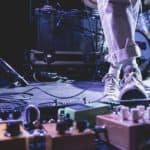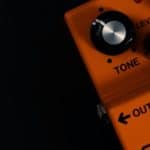When you run your guitar signal through many pedals it’s only natural that it will lose some strength by the end of its journey.
Buffer pedals are popular because they give an extra oomph to this signal that keeps it strong enough so you don’t perceive any noticeable decay in tone.
Some players, however, claim that an EQ pedal can do this job just as well.
But is this true?
Could EQ pedals also work as buffers?
And which is better to boost your signal, a standalone buffer pedal or an EQ one?
An always-on EQ pedal will work as a buffer, as any other pedal will, however, it is just a secondary function they have. Standalone buffers are designed to just power up your signal level in a way that compliments your tone. Not all buffers sound the same, and this is why many players prefer them.
In this article, I will tell you all you need to know about guitar signal degradation, how buffer pedals work, and why some players consider that EQ pedals could replace them.
After leaving this page, you will know if your rig demands some kind of boost like the one mentioned above, and whether a buffer pedal or an EQ pedal might be the best choice for you based on your rig and your play style.
Are you ready to get started?
Let’s go!
Why would you need to boost the signal of your guitar?
When a guitar signal leaves the instrument and starts traveling through a cable it is susceptible to interference and noise.
The longer its travel path, the more it will be affected until it reaches your amp.
This is to say, the more complex your pedalboard is, the higher the chances you could be experiencing some degree of tone decay.
This deterioration of your sound mainly presents itself on the higher-end. So if you feel like your guitar has lost some brightness, perhaps this is a place to start looking to get it back.
A simple way of checking if this is your case would be by just comparing how you sound when plugged straight into your amp compared with the sound of your signal running through your entire pedalboard, with everything switched off, of course.
If you notice any difference, you might need something to boost that signal at some point.
What are buffer guitar pedals?
Buffer pedals are guitar pedals that have the sole purpose of increasing the strength of your signal so it can travel through your entire rig without losing any of its original characteristics.
Buffer pedals are usually quite simple, and in some cases, they might not even have knobs, but just a switch.
They are usually put in the very front of the pedal chain so the signal gets immediately increased and has enough energy to go through almost unaltered.
There are some exceptions, like when you have fuzz pedals in place, where it’s recommended to put the buffer just after them so they can work properly.
Usually, buffer pedals should at max be put after overdrives, distortions, or fuzzes, but no further in the chain.
Are buffered pedals the same thing?
When we talk about buffed pedals we refer to guitar pedals that have a different main role other than buffing up your signal, however, they still incorporate a buffer function just for utilitarian purposes.
For instance, a lot of wah pedals are known for being buffered, such as certain tuners.
Since they are commonly used in front of all the rest of the effects in a regular rig, they sit at a point that’s optimal for buffering the signal.
However, I would not say that buffered pedals are the same thing as standalone buffers, since different buffers might have slightly dissimilar effects on your tone, and pedals built with the sole purpose of buffering might have dedicated controls for shaping your sound or a more curated effect on the signal.
Would an EQ pedal work as a buffer?
An EQ pedal will work as a buffer only when it’s turned on.
And this is also true for most other pedals.
This is why their buffered function is more important when they are turned off.
The thing that causes tone loss is your signal traveling through a long cable, that is what true bypass pedals end up being when turned off.
If at a certain point on the chain a pedal is turned on, the signal will be brought up in level. However, whatever loss in quality had happened before that point can’t be compensated.
Now, back to the original question: Since many players choose to put their EQ pedals in front of the rest of the chain, and use them as always-on pedals, they will surely work as buffers and be enough to dismiss the need for a standalone buffer.
It will mostly depend on player preferences and how tweaky they are with their tone.
I know some people that really want to control each aspect of their EQ at every point possible, and I also know many other players that just want a buffer with no knobs that they can stomp when they start playing and forget about any kind of tone loss.
What’s better for boosting your signal: a buffer or an EQ pedal?
If we are talking about the sole purpose of boosting a guitar signal, I would have to go with a standalone buffer pedal since it is designed specifically for that function, and may be voiced in a way that compliments guitar sound, or have controls intended for shaping your tone subtly.
An EQ pedal is not designed for that function specifically but for actively shaping the loudness of different frequency bands that compose your sound.
Yes, an always-on EQ pedal will have the same utility of boosting the signal as a standalone buffer, as I mentioned, but they are ultimately 2 very different pieces of gear, and you should decide upon what better suits your needs.
If you consider that tweaking certain aspects of your tone in a very granular way is a thing that could improve your sound, go for an EQ pedal, and benefit from its secondary buffering function.
If you are only worried about signal decay and tone loss, go for a standalone buffer, or strategically place some buffered pedals along your signal chain so they can boost it where it’s needed.
Remember, as always, to inform all your decisions with your ear.

Hello there, my name is Ramiro and I’ve been playing guitar for almost 20 years. I’m obsessed with everything gear-related and I thought it might be worth sharing it. From guitars, pedals, amps, and synths to studio gear and production tips, I hope you find what I post here useful, and I’ll try my best to keep it entertaining also.





